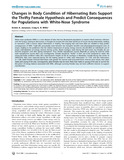| dc.contributor.author | Jonasson, Kristin A. | |
| dc.contributor.author | Willis, Craig K. R. | |
| dc.date.accessioned | 2016-11-28T21:51:16Z | |
| dc.date.available | 2016-11-28T21:51:16Z | |
| dc.date.issued | 2011-06-22 | |
| dc.identifier.citation | Jonasson, Kristin A., and Craig K. R. Willis. "Changes in Body Condition of Hibernating Bats Support the Thrifty Female Hypothesis and Predict Consequences for Populations with White-Nose Syndrome," PLoS ONE 6(6): e21061. DOI:10.1371/journal.pone.002106. | en_US |
| dc.identifier.issn | 1932-6203 | |
| dc.identifier.uri | http://hdl.handle.net/10680/1250 | |
| dc.description | 8 pages. | en_US |
| dc.description.abstract | White-nose syndrome (WNS) is a new disease of bats that has devastated populations in eastern North America. Infection with the fungus, Geomyces destructans, is thought to increase the time bats spend out of torpor during hibernation, leading to starvation. Little is known about hibernation in healthy, free-ranging bats and more data are needed to help predict consequences of WNS. Trade-offs presumably exist between the energetic benefits and physiological/ecological costs of torpor, leading to the prediction that the relative importance of spring energy reserves should affect an individual’s use of torpor and depletion of energy reserves during winter. Myotis lucifugus mate during fall and winter but females do not become pregnant until after spring emergence. Thus, female reproductive success depends on spring fat reserves while male reproductive success does not. Consequently, females should be ‘‘thrifty’’ in their use of fat compared to males. We measured body condition index (BCI; mass/forearm length) of 432 M. lucifugus in Manitoba, Canada during the winter of 2009/2010. Bats were captured during the fall mating period (n = 200), early hibernation (n = 125), and late hibernation (n = 128). Adult females entered hibernation with greater fat reserves and consumed those reserves more slowly than adult males and young of the year. Consequently, adult females may be more likely than males or young of the year to survive the disruption of energy balance associated with WNS, although surviving females may not have sufficient reserves to support reproduction. | en_US |
| dc.description.sponsorship | "This work was supported by the Natural Sciences and Engineering Research Council (NSERC, Canada) Discovery Grant to CKRW; the Canada Foundation for Innovation (CFI) Leader’s Opportunity Fund Grand to CKRW; the Manitoba Research and Innovation Fund Grant to CKRW; the NSERC Canada Graduate Scholarship to KAJ; the Manitoba Graduate Scholarship to KAJ; and the Bat Conservation International Student Research Scholarship to KAJ." | |
| dc.description.uri | http://journals.plos.org/plosone/article?id=10.1371/journal.pone.0021061 | |
| dc.language.iso | en | en_US |
| dc.rights | info:eu-repo/semantics/openAccess | |
| dc.subject | Bats -- Metabolism. | en_US |
| dc.subject | Bats -- Diseases. | en_US |
| dc.subject | Hibernation (Biology) | en_US |
| dc.subject | White-nose syndrome | en_US |
| dc.title | Changes in Body Condition of Hibernating Bats Support the Thrifty Female Hypothesis and Predict Consequences for Populations with White-Nose Syndrome | en_US |
| dc.type | Article | en_US |
| dc.identifier.doi | 10.1371/journal.pone.002106 | |

